COVER STORY
8. local startup ecosystem
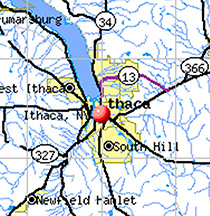
Image: Provided. See larger image
The new downtown Ithaca incubator, a collaborative venture among Cornell, Ithaca College and Tompkins Cortland Community College, opened in January, billed as a hub for economic activity in the area that will channel rising entrepreneurs from all three schools into the Ithaca community and surrounding area.
Located in the Carey Building in downtown Ithaca, the incubator is part of the new Southern Tier Innovation Hot Spot, a regional economic development initiative that received a three-year, $750,000 award from the state's Regional Economic Development Council.
The incubator project is being led by Tom Schryver '93, MBA '02, Cornell's newly appointed executive director of new venture advancement.
9. computerized prosthetic eyes that bypass damaged photoreceptor cells

Sheila Nirenberg. Image: MacArthur Foundation. See larger image
MacArthur "genius" fellow Sheila Nirenberg, associate professor of physiology and biophysics at Weill Cornell Medical College, has invented a device that could restore vision via a computerized eyeglass prosthetic.
Nirenberg, who explores fundamental questions about how the brain encodes visual information, developed this alternate approach for patients with photoreceptor cell degeneration (such as those who suffer from macular degeneration and retinitis).
Instead of trying to replace lost photoreceptor cells, Nirenberg's method bypasses the damaged cells entirely and interacts directly with ganglion cells, using neural "codes" generated in response to particular spatial and temporal visual patterns. The prosthetic transmits the codes to the ganglion cells, which then send them to the brain.
10. the growing biz
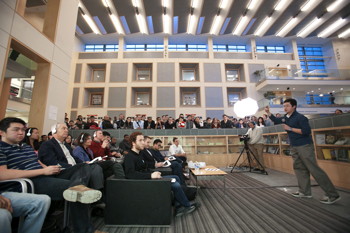
Feifan Zhou '16, CEO of TuneTap, gives his four-minute pitch to the judges during the second annual Johnson Shark Tank competition on Feb. 4. TuneTap, a service that enables artists and fans to crowdfund live events, won the competition. Photo: University Communications Marketing. See larger image
Every successful business, like any good idea, starts with a seed, that first moment of realization: This could really grow.
Shira Baly '14 got the idea for her company, GummyMed, in a Target store, while passing a shelf of gummy vitamins and wondering why no companies sell drugs in gummy form.
Michael Merrill '17 and Dan Masetti '17 got the idea for their daily coding challenge app, CodeProblems, while hanging out in Willard Straight Hall before a prelim.
Alex Krakoski '16 got the idea for his company, Worthy Jerky, when he made enough money selling homemade beef jerky out of his backpack at his high school in the Swiss Alps to pay for a trip around Europe. Arriving at Cornell the next year, Krakoski found many campus resources (classes, advice, contests, funding) to help entrepreneurial projects and started to grow his business. "It was an easy choice to pursue it further," he says.
Krakoski gained valuable perspective from professor Dan Cohen's Introduction to Entrepreneurship course in ILR, and he has worked with professors in the College of Agriculture and Life Sciences extensively. eLab, Cornell's startup accelerator based at the Samuel Curtis Johnson Graduate School of Management, has given him and his growing team access to veteran entrepreneurs and professors.
Worthy Jerky has matured from concept to business, with deals in place with several Ithaca stores and an e-commerce platform to take orders online. GummyMed and CodeProblems, both in development, won recognition at the Big Idea Competition in April.
Cornell has an atmosphere that encourages students to come up with new business ideas, and nurtures those new businesses, says Zach Shulman, director of Entrepreneurship@Cornell, a universitywide effort that helps students, faculty, staff and alumni find resources to start businesses, some in partnership with the Student Agencies Foundation.
– Kate Klein
11. ideas to look at
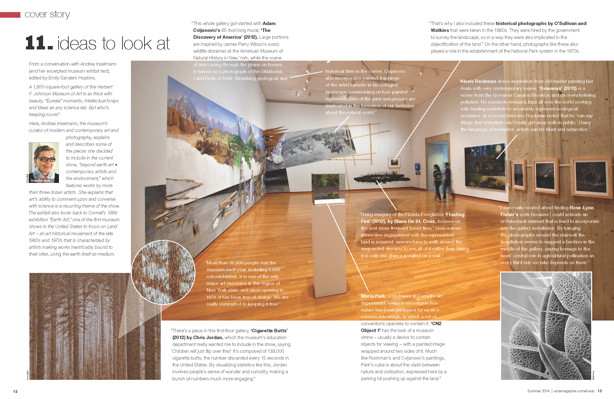
Johnson Museum view of "beyond earth art" exhibit with labeled items of interest click for large view. Photo: University Communications Marketing (Click for large view)
From a conversation with Andrea Inselmann (and her excerpted museum exhibit text), edited by Emily Sanders Hopkins.
A 1,800-square-foot gallery of the Herbert F. Johnson Museum of Art is as thick with beauty, "Eureka" moments, intellectual forays and ideas as any science lab. But who's keeping score?
-
Here, Andrea Inselmann, the museum's curator of modern and contemporary art and photography, explains and describes some of the pieces she decided to include in the current show, "beyond earth art
- contemporary artists and the environment," which features works by more than three dozen artists. She explains that art's ability to comment upon and converse with science is a recurring theme of the show. The exhibit also looks back to Cornell's 1969 exhibition "Earth Art," one of the first museum shows in the United States to focus on Land Art – an art historical movement of the late 1960s and 1970s that is characterized by artists making works inextricably bound to their sites, using the earth itself as medium.
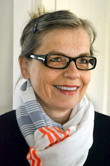
Andrea Inselmann. Photo: Johnson Museum See larger image
"This whole gallery got started with Adam Cvijanovic's 65-foot-long mural, 'The Discovery of America' (2012). Large portions are inspired by James Perry Wilson's iconic wildlife dioramas at the American Museum of Natural History in New York, while the scene of men racing through the plains on horses is based on a photograph of the Oklahoma Land Rush of 1889. Smashing geological and historical time in the corner, Cvijanovic also incorporates painted trappings of the artist's studio in his collaged landscape commenting on how painted representations of the past and present are implicated in the formation of our fantasies about the natural world."
"That's why I also included these historical photographs by O'Sullivan and Watkins that were taken in the 1860s. They were hired by the government to survey the landscape, so in a way they were also implicated in the objectification of the land." On the other hand, photographs like these also played a role in the establishment of the National Park system in the 1870s.
"Alexis Rockman draws inspiration from old master painting but deals with very contemporary issues. 'Gowanus' (2013) is a scene from the Gowanus Canal in Brooklyn and its overwhelming pollution. He conducts research trips all over the world working with leading scientists to accurately represent ecological scenarios. In a recent interview Rockman noted that he 'can say things that scientists can't really get away with in public.' Using the language of metaphor, artists can be blunt and subjective."
"More than 80,000 people visit the museum each year, including 8,000 schoolchildren. It is one of the only major art museums in this region of New York state, and since opening in 1973, it has been free of charge. We are really committed to keeping it free."
"There's a piece in this first-floor gallery, 'Cigarette Butts' (2012) by Chris Jordan, which the museum's education department really wanted me to include in the show, saying: 'Children will just flip over this!' It's composed of 139,000 cigarette butts, the number discarded every 15 seconds in the United States. By visualizing statistics like this, Jordan involves people's sense of wonder and curiosity, making a bunch of numbers much more engaging."
"Using imagery of the Florida Everglades 'Floating Fire' (2012), by Blane De St. Croix, focuses on the ever more frequent forest fires." Here a more interactive engagement with the represented land is required: viewers have to walk around the suspended diorama to see all of it rather than taking it in with one glance installed on a wall."
"Maria Park, a professor in Cornell's art department, seeks to investigate how nature has been packaged for us as a consumable image, in which a set of conventions operates to contain it. 'CN2 Object 1' has the look of a museum vitrine − usually a device to contain objects for viewing − with a painted image wrapped around two sides of it. Much like Rockman's and Cvijanovic's paintings, Park's cube is about the clash between nature and civilization, expressed here by a parking lot pushing up against the land."
"I was really excited about finding Rose-Lynn Fisher's work because I could activate an architectural element that is hard to incorporate into the gallery installation. By hanging the photographs around the stairwell the installation seems to suggest a beehive in the middle of the gallery, paying homage to the bees' central role in agricultural pollination as every third bite we take depends on them."
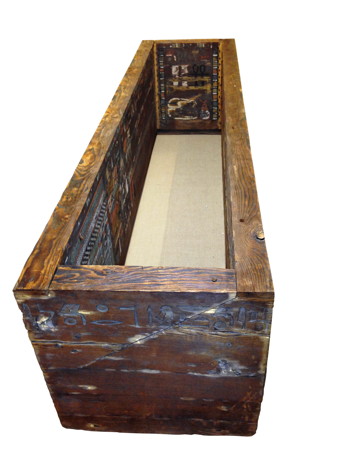
Egyptian coffin. Photo: Sturt Manning. See larger image
12. tree rings provide insight
A handful of tree ring samples stored in an old cigar box have shed unexpected light on the ancient world, thanks to research by archaeologist Sturt Manning and collaborators at Cornell and in Arizona, Chicago, Oxford and Vienna.
The samples were taken from an Egyptian coffin; Manning also examined wood from funeral boats buried near the pyramid of Sesostris III. He used a technique called dendro radiocarbon wiggle matching, which calibrates radiocarbon isotopes found in the sample tree rings with the patterns known from other places in the world.
Because the dating was so precise – plus or minus about 10 years – it helps confirm that the "higher" Egyptian chronology for the time period is correct, a question scholars have hotly debated.
But the samples also showed a small, unusual anomaly following the year 2200 B.C., when paleoclimate research has suggested that there was a major short-term arid event about this time.
"This radiocarbon anomaly would be explained by a change in growing season, i.e., climate, dating to exactly this arid period of time," says Manning, the Goldwin Smith Professor of Classical Archaeology and director of the Malcolm and Carolyn Wiener Laboratory for Aegean and Near Eastern Dendrochronology. "We're showing that radiocarbon and these archaeological objects can confirm and in some ways better date a key climate episode."
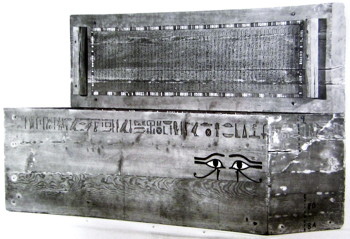
Egyptian coffin detail. Image: S. Cristanetti, A. Whyte/Oriental Institute, University of Chicago. See larger image
That climate episode, says Manning, had major political implications. There was just enough change in the climate to upset food resources and other infrastructure, which is likely what led to the collapse of the Akkadian Empire and affected the Old Kingdom of Egypt and a number of other civilizations.
"The tree rings show the kind of rapid climate change that we and policymakers fear," says Manning. "This record shows that climate change doesn't have to be as catastrophic as an Ice Age to wreak havoc. We're in exactly the same situation as the Akkadians: If something suddenly undid the standard food production model in large areas of the U.S., it would be a disaster."
– Linda B. Glaser

Parking meter. Image: Amanda Rohde/Hidesy. See larger image
13. let's pay more for parking
According to Michael Manville, assistant professor in City and Regional Planning, municipalities would be wise – and richer and more efficient and more pleasant to live and drive in – if they established market-based street parking rates.
The price of street parking should vary by block and time of day, with the aim of always keeping one to two spaces open on every block. Charging the right price for parking would deliver a better service to drivers – by ensuring they always find an open space – and also encourage more walking, cycling and transit use. Not least, it would raise revenue (without raising taxes) that cities could spend on services that residents value.
"Cities everywhere give away valuable land to drivers," Manville says. "Ending this quiet but huge subsidy will help the environment, the economy and the transportation system."
– Emily Sanders Hopkins
14. journal club
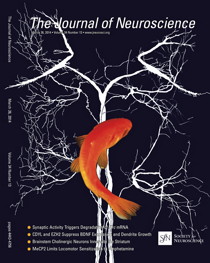
Image: Journal of Neuroscience See larger image
Monday in Mudd Hall is neurobiology and behavior journal club day, led by professors Kerry Shaw and Carl Hopkins, both in the Department of Neurobiology and Behavior. Hopkins had the idea for journal club, introduced in 2011, which asks undergraduate students to dive into the very latest research before they have mastered the fundamentals of biology and scientific research.
"Somehow," Hopkins explains, "the fact that the student is learning about something that most people in the university don't know about gives them a special feeling of being in the in-group. Since the results are so new … students are allowed to wonder if the data are solid, if the experiments are properly controlled."
After they've selected a paper to study out of hundreds published every month, students must analyze and make an oral presentation (with slides) on the new research.
"The students learn a great deal grappling with the primary literature and take away lifelong lessons on how to evaluate the newest scientific research," Shaw says.
Recent papers have covered how smell activates appetite; a neural mechanism of first impressions; phonetic feature encoding in the human brain; and why bonobos share with strangers.
– Emily Sanders Hopkins
<<View entire story as one page>>